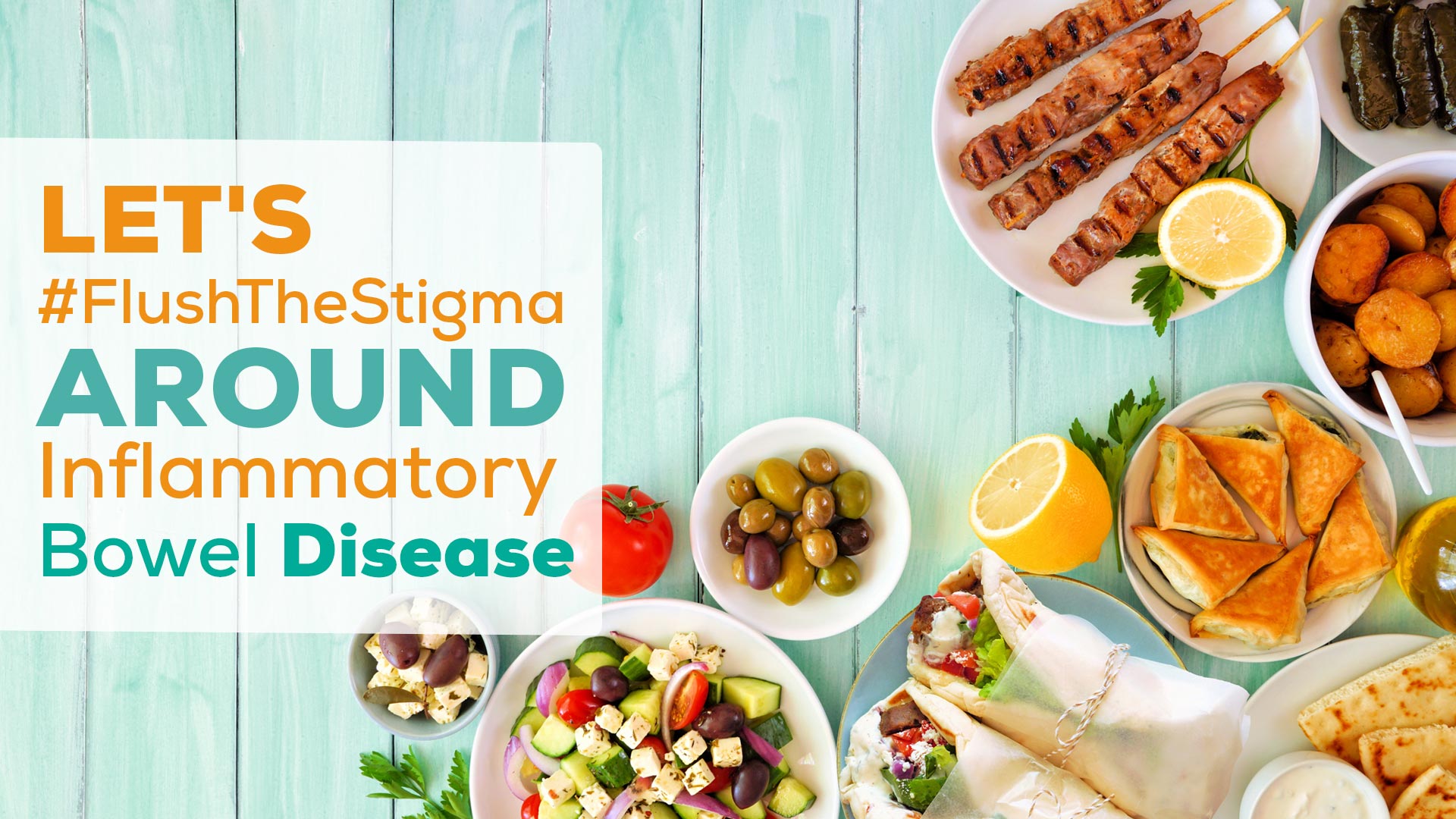
May is Crohn’s and Colitis Awareness Month. Let’s #FlushTheStigma around Inflammatory Bowel Disease (IBD) this May. It takes guts to talk about Crohn’s and colitis. Crohn’s and colitis impact Australians at all ages and stages of life. More than 100,000 – or 1 in every 250 Australians – live with IBD and it is becoming more prevalent in the community. In this month’s blog ORS dietitian and resident gut guru, Nicole Saliba unpacks what IBD is, why diet and lifestyle are so important, and the important role a dietitian plays in helping manage your condition.
What is IBD?
IBD is a term used to describe multiple gastrointestinal diseases characterised by chronic inflammation that damages different parts of the intestinal lining. Crohn’s disease (CD), ulcerative colitis (UC), and microscopic colitis are the most common types of IBD.
What causes IBD?
Crohn’s disease can cause inflammation anywhere along the digestive tract from the mouth to the anus but usually involves the small intestine and the first part of the large intestine. Microscopic colitis and UC cause inflammation solely in the large intestine. UC also leads to the formation of ulcers (small sores) in the large intestine. Common signs and symptoms of IBD may include diarrhoea, abdominal pain, and unexplained weight loss. UC may also cause blood, mucus, or pus in the stool, and urgent or persistent feelings of needing to have a bowel movement. Crohn’s disease may cause additional symptoms, including joint or eye pain, nausea, or iron-deficiency anemia. Severe cases of UC or Crohn’s may also lead to fever or lasting fatigue. Symptoms of IBD typically worsen during flares and resolve or significantly improve during periods of remission. Diagnosis is usually confirmed following a colonoscopy which allows the doctor to view the intestinal lining with a small camera and collect tissue samples for examination, which can confirm a diagnosis.
What role do diet and lifestyle play when it comes to IBD?
IBD is increasing globally which suggests there are things in our environment that are changing which are increasing our risk, including our diet. Research shows that a Western diet rich in animal protein, fats, and refined carbohydrates and low in fibre, fruits and vegetables may increase the risk of developing IBD. There seems to be a negative association between vegetable protein and IBD, i.e. it reduces your risk of developing it, while a high intake of animal protein, particularly red meat, seems to increase the risk. Patients with IBD are more likely to be vitamin D deficient too, and we know that vitamin D is important for our immune system. Patients are often told, “Eat what you can tolerate.” Despite this refrain, approximately 40% of patients with CD believe that diet can control symptoms while approximately 80% believe diet is important in the overall management of disease. Below is a summary of common dietary interventions for IBD:
Low-residue diet: A low-residue diet restricts your intake of high-fibre foods that are thought to be harder to digest or that stimulate the gut. When a low-residue diet is followed, it limits fibre intake to 10-15 grams a day. Fibre is a type of carbohydrate that contains undigested residue. These remains of fiber go into the stool and are what normally helps us to avoid constipation and maintain bowel health. However, it is thought by some that this residue can trigger symptoms for those with IBD. The goal of a low residue diet is to limit the number of indigestible fibers that enter the gut, making the digestive tract do as little work as possible and therefore reducing your chances of bowel movements and symptoms. Low-residue diets have been traditionally recommended short-term during disease flares or post-operatively in patients with inflammatory bowel disease (IBD) to reduce pain or lower the risk of bowel obstructions.
Exclusive enteral nutrition EEN and partial enteral nutrition PEN: Exclusive enteral nutrition — which uses specific liquid formulas to meet a patient’s dietary needs — can induce remission, especially in paediatric patients with IBD. Emerging evidence suggests that partial enteral nutrition can prevent flares when a patient is in remission, especially when fed through a nasogastric tube that delivers the formula directly into the stomach through the nose.
The best dietary sources are: The specific carbohydrate diet is a whole food diet with an emphasis on fruits, most vegetables, fresh legumes, meat, seafood, hard cheeses, and yogurt fermented for more than 24 hours. It avoids grains, starchy vegetables, most dairy, processed foods, artificial sweeteners, emulsifiers, cocoa, and sugars outside of honey. In an anonymous survey of 417 pediatric and adult patients with IBD on the SCD, 36% reported clinical remission by one to three months, with an additional 34% at greater than three months. Of those who reached remission, 47% reported improvement in abnormal laboratory values.
Low FODMAP diet: Studies suggest that IBS can co-exist in around 40% of IBD patients. The low FODMAP diet can be useful for IBD patients who are in remission but are still experiencing functional GI symptoms such as bloating, abdominal pain, and variable bowel habits. Three studies have thus far shown that 50 to 78% of IBD patients on a low FODMAP diet can have a reduction in their abdominal pain, bloating, flatulence, nausea, and belching.
The Mediterranean diet (MD): The Mediterranean diet (MD) is characterised by a higher consumption of vegetables, fruits, cereals/whole grains, nuts, legumes, and unsaturated fat, with a moderate intake of fish and dairy, and reduced consumption of saturated fat, meat, and sweets. It has been shown to have a wide range of health benefits largely due to its anti-inflammatory properties. In overweight patients with IBD, the MD has been shown to reduce BMI waist circumference, and liver fat. These improvements were associated with reduced levels of inflammation and disease activity. It has been shown to reduce faecal calprotectin levels too, which is a measure of inflammation in the bowel
Food additives: Randomised controlled studies in humans also suggest that food additives such as emulsifiers and thickeners contribute to intestinal inflammation, so it is best to limit ultra-processed foods and read your labels.
Is there a role for supplements?
Most evidence indicates that probiotics, prebiotics (including resistant starch), and synbiotics may be effective in inducing remission and reducing some symptoms of IBD, especially in UC. Emerging evidence suggests that resveratrol and curcumin might improve gastrointestinal symptoms and quality of life, while vitamin D and omega-3 fatty acid supplementation could reduce inflammation and encourage cell turnover for the repair of the intestinal lining. In patients under 40, curcumin also appears to improve remission rates.
How can a dietitian help?
A dietitian can help:
-
- >> Screen and treat malnutrition
- >> Monitor for nutrient deficiencies and make recommendations around what foods to eat or supplements to take to address these
- >> Screen for eating disorders and work with patients or clients to improve their relationship with food
- >> Recommend and help implement specific therapeutic diets such as a low FODMAP diet, low residue diet, or Mediterranean diet
- >> Patients increase their food variety and reduce anxiety around eating
- >> Patients reduce their symptoms
- >> Patients navigate their diet after surgery
- >> Support clients with IBD who want to conceive as they have unique nutrient and supplement requirements
- >> Answers all questions patients may have about nutrition for IBD.
Do you have IBD and feel you may benefit from dietetic input? Book in with one of our experienced ORS dietitians today by calling
ORS on 1800 000 677 or our Eastsense by ORS clinic on 02 4311 3623.
Nicole Saliba – Clinic Manager
Dietitian, BHlthSc(Nutr&Diet), APD
Sources
1. Frank A Cusimano, DO, PhD1, Oriana M. Damas. Diet as treatment for inflammatory bowel disease: is it ready for prime time? Curr Opin Gastroenterol. 2022 July 01; 38(4): 358–372.
2. Shoda R, Matsueda K, Yamato S, Umeda N. Epidemiologic analysis of Crohn disease in Japan: increased dietary intake of n-6 polyunsaturated fatty acids and animal protein relates to the increased incidence of Crohn disease in Japan. Am J Clin Nutr. 1996 May;63(5):741–5.
3. 23. Jantchou P, Morois S, Clavel-Chapelon F, et al. Animal protein intake and risk of inflammatory bowel disease: the E3N Prospective Study. Am J Gastroenterol. 2010;105:2195–201.
4. Hashash JG, Elkins J, Lewis JD, Binion DG. AGA Clinical Practice Update on Diet and Nutritional Therapies in Patients With Inflammatory Bowel Disease: Expert Review. Gastroenterology. 2024 Mar;166(3):521-532. doi: 10.1053/j.gastro.2023.11.303. Epub 2024 Jan 23. PMID: 38276922.
5. Halmos EP, Godny L, Vanderstappen J, et alRole of diet in prevention versus treatment of Crohn’s disease and ulcerative colitis Frontline Gastroenterology 2024;15:247-257.

